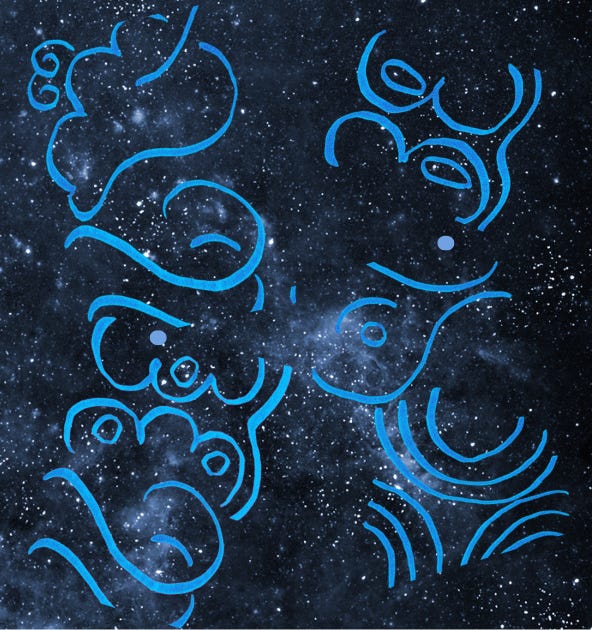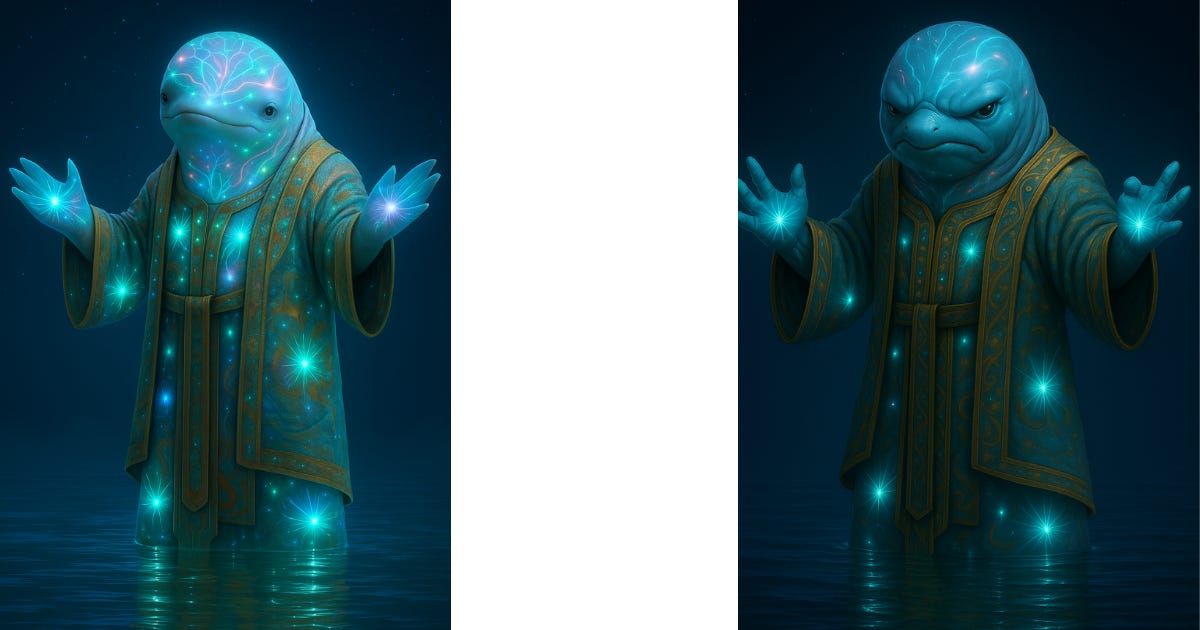Multimodal Meaning
Crafting the Whale’s Tongue — Essay Six
Meaning lives in context, not in the signal itself.
The word “set” has more than 400 meanings in English.
A tennis set. A movie set. To set the table, to set your jaw. The sun set. Same sound, wildly different implications.
And then there’s tone. A flat “Nice job” can wound more deeply than a shouted insult, while the same two words in another context may land as genuine praise.
Language is never just the word itself—it’s the timing, the context, and the gesture that accompanies it.
So what if every word you spoke could change meaning depending on when, where, and how it was performed?
For the Biet Lagos, that’s not a thought experiment. It’s survival.
Threlraan’s Multimodal Layers
We’ve already seen how the Biet Lagos communicate: pulses of bioluminescent light shimmering through their skin, resonant clicks produced by the thuln, and gestures that range from subtle fin-curls to full-bodied arcs.
Each channel on its own conveys only a fragment. A flash of blue light alone is noise. A string of clicks, absent light, is ambiguous. Gesture without rhythm is just movement.
Together, though, they converge into meaning.
A glyph in Threlraan is not a word in the human sense. It is a chord—sound, light, and movement performed together, each one inseparable from the others.
Context-Dependence
Here’s where it gets tricky. The same glyph, performed the same way, can shift meaning entirely depending on context.
A pulse pattern that in ritual means welcome may, in the charged atmosphere of combat, signal warning.
Registers matter. Just as humans switch between casual conversation, formal speech, and interstellar radio code, the Biet Lagos carry registers in ritual, everyday exchange, and transmissions sent across space.
Think of it like tone of voice in our world. Words are the same, but tone is everything. “I love you” can bless or wound depending on whether it’s whispered, shouted, or muttered through clenched teeth.
Shared Experience as Prerequisite
Meaning also depends on what speaker and listener share. Without shared reference, even a perfectly performed glyph can dissolve into noise.
One example: a light-pulse pattern only performed during spawning season. Within the community, its meaning is clear, layered with generations of shared experience. To an outsider, it is indecipherable.
Communication theorists call this the frame of reference—encoding and decoding don’t happen in a vacuum. Meaning lives in context, not in the signal itself.
Story Tie-In: Jayla’s Realization
This is why Jayla, my xenolinguist protagonist, can never decode Threlraan from a transmission alone. Rhythm and light may get her part of the way—enough of the way for Book One—but the pulse without the season, the gesture without the ritual, will always fall short.
Her first realization is subtle—the recognition that rhythm alone is not enough. She must see, hear, and feel the language in its living context. Presence matters. In World Beyond the Song, the Biet Lagos will have sent their simplest message possible with the best chance of intended translation.
That breadcrumb will set her on a path beyond World Beyond the Song and deeper into the Trinity of the Threaded Deep where there is more to the Biet Lagos culture than she could ever have imagined.
Human Parallels
We know this problem well. Idioms, irony, poetry—all demand shared cultural background.
Consider Indigenous languages where the word for a certain plant carries different meanings depending on season, place, or ritual setting. Or the impossibility of translating sarcasm without the knowing wink or tone of voice.
Translation often fails not because words can’t cross borders, but because experience cannot.
Closing Reflection — Language as Living Context
For the Biet Lagos, meaning is not fixed. It is performed.
To pulse, to click, to gesture in rhythm is not just to speak, but to enact truth in the moment. Multimodality is not an ornament to their language; it is survival itself.
And yet this leaves us with a question: what happens when this living, contextual language must cross the void—when Jayla must carry it across worlds, and across translation?
That is where we turn next: Translating the Untranslatable.
Each essay in this series builds another layer of Threlraan. If you’d like to keep exploring how meaning is performed and transformed, consider subscribing to walk this path with me.








What I've been wondering in reading this series is how could a human communicate in this language? It seems so species-specific, needing the ability to create clicks and light pulses. For a being without those abilities, I imagine it will be quit the challenge to communicate! But that's what makes it so fascinating, the desire to see that process of joining cultures. I'm really enjoying this and can't wait to read the book! 😁
What struck me most about this essay was the human parallels. As a reluctant writer, I fear that someone might misinterpret a conversation between characters I created. I knew what I wanted to say and the feeling I wanted to convey, but someone who doesn't speak English as their first language may not understand. In diplomacy, misinterpretations could lead to conflict or worse. On the World Wide Web, it gives some a voice, who through anonymity, can criticize, compliment, not realizing that their silence may speak louder than their words.
Many words for the same plant depending on the season. It's hard to picture Threlraan, since the language you've invented involves so much more than just color, tone, and rhythm. It's almost as if you are preparing us for an eventual takeover?